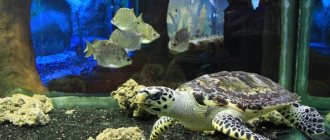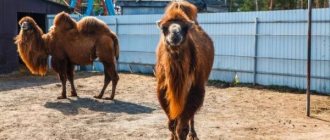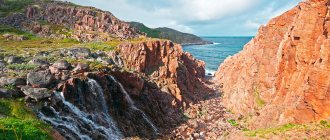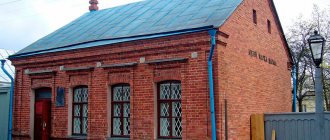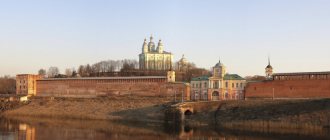Kursk is a city of military glory, one of the greatest cultural, religious, scientific, educational and industrial centers of Russia. It was the main southern fortress of the Kursk Principality in the 16th century and an important commercial, industrial, and railway center of Russia in the 18th–19th centuries.
The famous Battle of Kursk in 1943 brought real fame to the city. When visiting Kursk, try to find time to visit its museums and see the memorial sites associated with this event, even if you only have one day.
For tourists who plan their route in advance, we have prepared a list describing the main attractions and interesting places in Kursk, reflecting different periods of the city’s thousand-year history.
Nature reserves and gladioli, a magnetic anomaly, estates and places of memory - all the most interesting things around Kursk in the material about the Kursk region.
Military History Museum of the Battle of Kursk
Address: Russia, Kursk, st. Sonina, 4 Telephone: Opening hours: • Wed., Thu., Fri., Sat., Sun. — from 09:00 to 16:00 • Mon., Tue. — closed • last Thu. month - sanitary day Ticket price: • adults - 101 rubles. • students – 55 rub. • schoolchildren – 49 rubles. • preschoolers – 7 rub.
Dedicated to one of the greatest battles of the Second World War of 1939-1945. The museum is located in the building of the House of Officers, the former site of the Kursk noble assembly. The exhibition contains numerous samples of captured Soviet weapons and military equipment, various historical documentary materials (graphs, diagrams, maps, models) and authentic items of personal belongings of participants in the Battle of Kursk - photographs, orders, medals, letters, etc.
In total, the museum's fund includes more than 10 thousand exhibits, highlighting the world-historical significance of the battle for the outcome of the Second World War, the periods of preparation and conduct of the battle, as well as the life of Kursk residents after the liberation of the city from the occupying forces. Of particular interest in the Kursk exhibition is the largest Russian diorama of the tank battle near Prokhorovka in 1943, “The Battle of Kursk”, created jointly by a creative group of battle artists, the total area of which is 1005 square meters. m.
In addition, the museum offers an excellent opportunity to plunge into the atmosphere of wartime by watching the documentary film “On the Scorched Land” or visiting a fascinating excursion dedicated to the Battle of Kursk from its first to its last day.
For those interested in military topics, another similar interesting museum-attraction is located in Saransk.
A little history
Kursk is an interesting city. The settlement on this site was founded no later than the 8th century. Kursk is mentioned in the chronicle under 1095. That is, in any case, older than Moscow.
But located on the edge of the great steppe, the city suffered greatly during the Mongol invasion. Then the Kursk land was part of the Lithuanian state.
In 1508 it was annexed to the Moscow state. At that time, Kursk was a marginal border point, where living was very dangerous. Ivan the Terrible even exiled criminals there.
By the end of the 16th century the city was completely deserted. The year of its refounding is considered to be 1586.
After we visited Kursk, it became clear why life had returned to the city. Kursk is located on the Central Russian Upland, on the Tuskar River, which flows into the Seim. The small river Tuskar and its tributary Kur (according to one version, Kursk is named after it), whimsically meandering, carved very deep valleys in the hills. The elevation changes in Kursk are very large. And on the tops of hills with steep cliffs, the construction of a fortress simply suggests itself. Which was built in 1596 and defended the Russian state from the south.
The glorious border past of Kursk is evidenced by the old names of the city districts: Soldatskaya, Streletskaya, Pushkarnaya and Kozatskaya Sloboda.
In 1781, after a fire, a new general plan for the city was adopted, according to which it received a rectangular street system. In 1797 the city became the center of the province. Located on the shortest route from Moscow to Crimea and Kyiv, the city developed rapidly and before the revolution became a major commercial and industrial center.
In the 20th century, the city grew especially rapidly, and now its population is about 435 thousand people.
On November 4, 1941, the city was occupied by the Germans and liberated at the end of February 1943. The city gave its name to the military battle that determined the final turning point in the Great Patriotic War. The Battle of Kursk, which ended in our victory, lasted about 50 days. Numerous monuments in the city and surrounding area remind of that time.
Now the city looks quite prosperous, well-groomed, there are many new buildings.
However, income in the city is apparently small. This is evidenced, in particular, by the price of tickets on public transport, only 14 rubles.
Memorial complex "Kursk Bulge". Triumphal Arch
Address: Pobeda Avenue
Another tribute to the memory of the Battle of Kursk in 1943. The architectural ensemble includes the Triumphal Arch, chapels, the Church of St. George the Victorious, a monument to the great commander Zhukov, a monument to the unknown soldier, an exhibition of Soviet military equipment and the Eternal Flame memorial.
The 24-meter-high arch is crowned with a sculptural composition of St. George the Victorious slaying a dragon with his spear - this is a symbol of military valor, courage and fearlessness. The walls of the monument are decorated with texts and statues of soldiers from early eras glorifying the spirit of the Russian warrior. Today, the Arc de Triomphe is a favorite place for walks, leisure time and wedding photo shoots for Kursk residents.
Oryol Region
Distance from Kursk - 120 kilometers
In the village of Dolbenkino, on the border of the Kursk and Oryol regions, there is a real Old Russian park. The mill, wooden stove, cart, and hut were made with their own hands by local residents - the Bulychev family. They also organized a local history museum, where you can hear about the history of the village, find out what the royal family did here, hear many stories about the local church and much more.
. . .
Kursk Museum of Archeology
Address: Russia, Kursk region, Kursk, st. Pionerov, 6 Telephone: , 54-91-94 Website: archeo-kursk.narod2.ru Opening hours: • from 9.30 to 17.00 without breaks and days off • last Thursday. month - sanitary day Ticket price: • adults - 50 rubles. • children – 25 rub.
One of the oldest stone buildings in Kursk architecture and a monument of federal significance. Initially, it was the voivodeship estate of the Romodanovskys (“Chambers of the Romodanovsky Boyars”), descendants of Grand Duke Vladimir Monomakh and the Rurikovich family. The entire appearance of the house is a striking example of the architectural traditions of Moscow Rus' of the 18th century. The building itself was built without a foundation and is supported by the thickness of the walls and screeds.
Unfortunately, to this day neither the date nor the author of the structure are fully known. Only the first owner of this magnificent building has been identified - the merchant Semyon Ivanovich Khloponin, who owned it at the end of the 18th century.
The museum's exhibitions contain unique artifacts and archaeological finds covering the history of the Kursk region from the Paleolithic to the Middle Ages. Women's jewelry, tools, military uniforms, coins, household items and religious traditions - the entire collection fund of the museum numbers about 200 thousand exhibits. The “highlight” of the Kursk State Regional Museum of Archeology is the diorama of the Avdeevskaya Paleolithic site (22,000 BC), located in the very center of the exhibition.
What to see in Kursk
Kursk is a big city, but modern microdistricts are not of particular interest; they are the same everywhere. A significant part of the city is occupied by streets lined with one or two-story private houses, which is also not very interesting.
The beauty and originality of most Russian cities is given by old buildings, which in Kursk are concentrated in a relatively small area.
Having arrived at the station, we first went to the Root Hermitage, and from there to the city center.
It takes a bus about 20 minutes to get to Red Square from the station, a minibus is faster. The main tourist attractions of Kursk fit into the territory bounded by Sonin, Dzerzhinsky, Alexander Nevsky, Radishchev, Gorky and Sadovaya streets.
Red Square of Kursk is not at all similar to its Moscow namesake, except that it is also large. From Lenin Street there is an entrance, framed by two large buildings with columns, which looks like a cut.
On this square is the House of the Soviets, quite decent in good Soviet style.
Lenin stands in front of him, as expected, with his hand outstretched.
Kursk is located 500 km south of Moscow and is noticeably warmer there. On April 9, when we were there, it was a warm day in Moscow, but in Kursk it was very hot, many were dressed like summer. But Kursk Lenin is doomed, at the whim of the sculptor, to forever be dressed warmly - a coat is thrown over his suit.
Alexander Nevsky stands on the same square. Whatever you want, this monument seemed inexpressive to me.
Art Gallery named after A. A. Deineka
Address: Russia, Kursk, st. Sovetskaya, 3 Phone: Website: deinekagallery.ru Opening hours: • 9.00-17.30 • 10.00-17.00 - visit • Mon. — day off Ticket price: • Schoolchildren — 10 rubles. • Students - 15 rubles. • Adults - 20 rub.
This is a classic museum of artistic creativity, the collection of which contains more than eight thousand works of domestic and Western European art of the 16th-21st centuries. The main asset of the gallery are the works of artists whose names, lives and activities are inextricably linked with the history of Kursk. For example, a native Kursk resident and Soviet painter Alexander Deineka, after whom the gallery was later named. He left the city a legacy of more than a thousand of his paintings, including the well-known painting “Defense of Sevastopol.”
The rest of the gallery’s collection consists of paintings, graphics, sculpture, decorative, applied and folk art of domestic and foreign masters of the 16th–19th centuries.
The peculiarity of the modern house of paintings named after A.A. Deineki is the eclecticism of the institution, combining in its activities traditional museum forms with new types of demonstration, for example, cartoon lectures and mini-tours “Merchant Kursk”, “Orthodox Kursk”, “Military Kursk”, etc.
About the architecture of Kursk
There are several interesting architectural sites in Kursk. My favorite was the Book House, built in the style of Stalin times, but with a clear Italian influence. Pure Italian palazzo.
memorial plaque to the architect of the House of Books
Interestingly, the building was built as a bookstore, and they still sell books there. The interior of the store has been slightly changed and modernized. In my opinion, not entirely successful. But the rethinking of the images of literary authorities, whose sculptural portraits are presented in the store’s hall, is both witty and, in my opinion, not offensive.
Bank buildings are memorable
Medical University, Pushkin Theater,
circus with a monument to Nikulin and Shuidin,
modern shopping center.
The center of Kursk has its own, completely individual architectural appearance.
New Luzhkov style building
Lenin hidden in courtyards
Cathedral of the Icon of the Mother of God “The Sign” (Znamensky Cathedral)
Address: Russia, Kursk, Lunacharskogo, 4 Telephone: , 56-11-97 Opening hours: • 8.00−20.00 • Sat. — 8.30−20.00
Erected in 1816–1826, the temple commemorates the triumphant victory in the war with Napoleonic France in 1812. In addition, the cathedral is a masterpiece of Russian Renaissance architecture and is designed in the style of traditional Western European classicism.
It was here that for a long time the famous miraculous icon of the Mother of God “The Sign” was located, which is where the name of the temple itself came from. Now the Znamensky Cathedral belongs to the Russian Orthodox Church and is actively operating.
Voronezh region
Distance from Kursk - 190 kilometers
The longest suspension bridge in the Black Earth Region is located in the village of Strelitsa. Its length is 300 meters. There is also an ideal place for a weekend nearby. The white well is mountains, sand, lake. Might make a good weekend itinerary.
. . .
Church of the Assumption of the Virgin Mary
Address: Russia, Kursk, st. Marata, 31 Phone: Website: uspenie.kursk.ru Opening hours: • Mon., Tue., Thu., Sat. — 17.00−20.00 • Wed. — 9.00−18.00 • Sun. — 9.30−15.30
The church, dating back to 1859, is the only Catholic church in Kursk. This is a classic example of a “Polish church”, made in the neo-Gothic style. It was here that the founder of Suprematism, Kazimir Malevich, got married and baptized his children during his long stay in the city. The artist also actively participated in the restoration work of the temple icons.
The church is equipped with an electric organ, to which masses are held. In addition, organ music concerts are regularly organized in the temple.
In many Russian cities, churches were built if many Lithuanians or Poles lived there - for example, the Church of the Holy Rosary is a landmark of Vladimir.
Oryol Region
Distance from Kursk - 120 kilometers
The castle of Vasily Okhotnikov is an unusual building, which is located on the border of the Kursk and Oryol regions in the village of Yakovka. If you have long dreamed of visiting Europe and admiring beautiful architectural structures, this place is especially for you. There was once a sugar factory here, which the landowner built in the 19th century. He traveled a lot in Europe and became imbued with the architecture of those places. There were rumors that in the left tower of the castle, General Okhotnikov held spiritualistic seances and communicated with the souls of his ancestors. The castle is now abandoned.
. . .
Apple Monument
Address: st. Lenina, 15a
A huge monument in the shape of a metal apple weighing 150 kilograms. Created in 2008 according to the design of the famous sculptor Vyacheslav Klykov, a native of the Kursk region, who managed to turn his unusual idea into a bright landmark of the city. This monument is a modern symbol of the apple region - Kursk - and a reminder of the former glory of the Kursk Antonovka, which dates back to the time of Catherine II, a famous lover of liquid apples.
A short video clearly demonstrating Kursk from different sides - its central attractions and residential outskirts:
Cities where you can find many unusual monuments:
- Tyumen
- Voronezh
If you have not yet chosen where you will live and want to save money when booking, we recommend using the RoomGuru service. Firstly, it contains hotels, apartments and guest houses from many different booking systems, so you won’t miss out on a worthwhile option. Secondly, you can immediately compare prices for one place in different services and book where it is cheaper (this is not always Booking!).
Railway station
A train from Moscow arrives at the city's main station. The station building was built after the war. The pompous huge structure was fully consistent with the position of the city, which was the main gate to the south. Remember how, in Soviet times, countless trains carried Muscovites from the Kursk station to the Black Sea resorts.
Now, in connection with the well-known events in Ukraine, this direction has become a dead end. There is now no way for us beyond Belgorod. Although some trains still go to Ukraine, their number is not comparable to the old days.
But the railway station is located quite far from the city center. You need to get there by bus or minibus. But there are no problems with this, transport runs smoothly. The landmark of the center is the name “Red Square”
